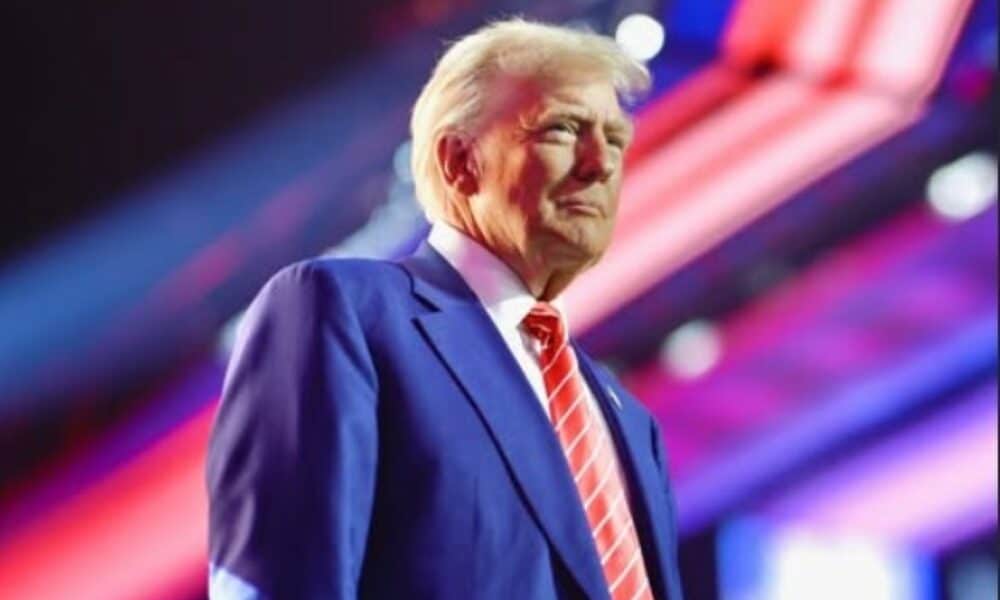Trump fires General Charles Q. Brown and carries out a major overhaul of the U.S. military leadership
President of the United States, Donald Trump, has undertaken a significant overhaul of the country’s military leadership by firing General Charles Q. Brown, Chairman of the Joint Chiefs of Staff. Brown, who had held the position since 2023, was officially dismissed on Friday (21) as part of a broader restructuring that also led to the removal of other top officials at the Pentagon. Trump’s decision has sparked immediate reactions, as it comes amid his criticism of the military leadership, which, according to him, has been excessively focused on diversity policies rather than combat readiness. The Trump administration aims to reshape military command structures to align national defense with the “America First” doctrine.
General Charles Q. Brown Jr., a veteran of the Air Force, was the second African American to serve as Chairman of the Joint Chiefs of Staff. Appointed by former President Joe Biden, Brown had a distinguished four-decade military career, including leadership roles in international operations. His removal is seen by analysts as part of Trump’s broader strategy to consolidate his influence over the defense sector.
In the same statement announcing Brown’s dismissal, Trump named retired General Dan Caine as the new Chairman of the Joint Chiefs of Staff. Caine, known for his role in special operations and national security, is viewed as a close ally of the president and someone aligned with his military priorities.
Trump demite chefe das Forças Armadas dos EUA https://t.co/chkGkakD9P #g1 pic.twitter.com/R9qNZ1hNGM
— g1 (@g1) February 22, 2025
Pentagon overhaul includes the removal of other high-ranking officers
The firing of General Charles Q. Brown was not an isolated event. As part of the broader shake-up in the military command, Trump also dismissed Admiral Lisa Franchetti, the first woman to serve as the Chief of the U.S. Navy. Additionally, General James Slife, Vice Chief of Staff of the Air Force, was also removed, along with several top legal advisors of the Armed Forces.
These dismissals come as the Trump administration seeks to redefine the military leadership structure, emphasizing the need for a renewed focus on combat readiness and operational effectiveness. The decision to remove high-ranking officials who played crucial roles in national defense highlights a shift in approach that could have direct implications for the U.S. military strategy in the coming years.
Dan Caine’s appointment signals a new direction for the U.S. military
The selection of Dan Caine to replace Charles Q. Brown marks a new phase in American military leadership. Caine, an Air Force veteran with extensive combat experience, is known for his involvement in counterterrorism operations in the Middle East. During Trump’s first term, Caine was praised for his role in dismantling ISIS cells.
The new Chairman of the Joint Chiefs of Staff brings a profile that aligns with Trump’s vision for the Armed Forces. His main priorities include strengthening the offensive capabilities of the U.S. Army, investing in military modernization, and prioritizing special operations. His background as an entrepreneur in the security sector also reinforces the perception that his leadership will be pragmatic and results-oriented.
Impact of dismissals on U.S. defense structure
The sudden departure of high-ranking military officials raises concerns about the potential effects on national security stability. Analysts point out that while replacing commanders is a presidential prerogative, the scale of these dismissals could create operational instability.
Key areas that may be affected by this overhaul include:
- Changes in global military strategy: The new leadership may revise the U.S. stance on international conflicts and joint operations with allies.
- Restructuring of military doctrine: The Trump administration may prioritize changes in how the Armed Forces operate, reducing investments in diversity training and increasing the focus on combat operations.
- Possible internal resistance: The replacement of experienced officers may cause dissatisfaction among high-ranking military personnel, potentially affecting the chain of command and operational efficiency.
History of military leadership changes under the Trump administration
This overhaul is not the first time Donald Trump has made significant changes in military command. During his first term, he had already dismissed several military leaders, citing misalignment with his strategic directives.
Some of the major changes previously implemented by Trump include:
- Firing of Secretary of Defense Mark Esper (2020) – Due to disagreements over using troops to suppress domestic protests.
- Removal of General Joseph Votel (2019) – Former head of U.S. Central Command, replaced by a commander more aligned with the administration’s strategies.
- Revision of U.S. military strategy in the Middle East – Withdrawal of troops from Afghanistan and Syria, altering the course of prolonged operations.
This pattern of leadership changes indicates a continuous effort by the president to ensure that the Armed Forces align with his political and strategic directives.
The future of U.S. military policy under the new Pentagon leadership
With the appointment of Dan Caine and the removal of officers who symbolized diversity policies, the Trump administration takes a clear step toward a more traditional and combat-focused approach. Expectations are that the new military leadership will implement policies emphasizing operational readiness, investments in military technology, and a reduction in the Armed Forces’ involvement in initiatives not directly related to combat.
Among the challenges for the new military leadership are:
- Ensuring stability during command transitions to prevent immediate operational disruptions.
- Revising internal policies on promotions and training to align with new presidential directives.
- Defining new strategic priorities concerning U.S. military presence abroad.
The Pentagon reshuffle initiated by Trump signals a significant shift in the United States’ military approach, with potential implications both domestically and for international relations. The coming months will be crucial in assessing how these changes will impact the U.S. defense structure.

President of the United States, Donald Trump, has undertaken a significant overhaul of the country’s military leadership by firing General Charles Q. Brown, Chairman of the Joint Chiefs of Staff. Brown, who had held the position since 2023, was officially dismissed on Friday (21) as part of a broader restructuring that also led to the removal of other top officials at the Pentagon. Trump’s decision has sparked immediate reactions, as it comes amid his criticism of the military leadership, which, according to him, has been excessively focused on diversity policies rather than combat readiness. The Trump administration aims to reshape military command structures to align national defense with the “America First” doctrine.
General Charles Q. Brown Jr., a veteran of the Air Force, was the second African American to serve as Chairman of the Joint Chiefs of Staff. Appointed by former President Joe Biden, Brown had a distinguished four-decade military career, including leadership roles in international operations. His removal is seen by analysts as part of Trump’s broader strategy to consolidate his influence over the defense sector.
In the same statement announcing Brown’s dismissal, Trump named retired General Dan Caine as the new Chairman of the Joint Chiefs of Staff. Caine, known for his role in special operations and national security, is viewed as a close ally of the president and someone aligned with his military priorities.
Trump demite chefe das Forças Armadas dos EUA https://t.co/chkGkakD9P #g1 pic.twitter.com/R9qNZ1hNGM
— g1 (@g1) February 22, 2025
Pentagon overhaul includes the removal of other high-ranking officers
The firing of General Charles Q. Brown was not an isolated event. As part of the broader shake-up in the military command, Trump also dismissed Admiral Lisa Franchetti, the first woman to serve as the Chief of the U.S. Navy. Additionally, General James Slife, Vice Chief of Staff of the Air Force, was also removed, along with several top legal advisors of the Armed Forces.
These dismissals come as the Trump administration seeks to redefine the military leadership structure, emphasizing the need for a renewed focus on combat readiness and operational effectiveness. The decision to remove high-ranking officials who played crucial roles in national defense highlights a shift in approach that could have direct implications for the U.S. military strategy in the coming years.
Dan Caine’s appointment signals a new direction for the U.S. military
The selection of Dan Caine to replace Charles Q. Brown marks a new phase in American military leadership. Caine, an Air Force veteran with extensive combat experience, is known for his involvement in counterterrorism operations in the Middle East. During Trump’s first term, Caine was praised for his role in dismantling ISIS cells.
The new Chairman of the Joint Chiefs of Staff brings a profile that aligns with Trump’s vision for the Armed Forces. His main priorities include strengthening the offensive capabilities of the U.S. Army, investing in military modernization, and prioritizing special operations. His background as an entrepreneur in the security sector also reinforces the perception that his leadership will be pragmatic and results-oriented.
Impact of dismissals on U.S. defense structure
The sudden departure of high-ranking military officials raises concerns about the potential effects on national security stability. Analysts point out that while replacing commanders is a presidential prerogative, the scale of these dismissals could create operational instability.
Key areas that may be affected by this overhaul include:
- Changes in global military strategy: The new leadership may revise the U.S. stance on international conflicts and joint operations with allies.
- Restructuring of military doctrine: The Trump administration may prioritize changes in how the Armed Forces operate, reducing investments in diversity training and increasing the focus on combat operations.
- Possible internal resistance: The replacement of experienced officers may cause dissatisfaction among high-ranking military personnel, potentially affecting the chain of command and operational efficiency.
History of military leadership changes under the Trump administration
This overhaul is not the first time Donald Trump has made significant changes in military command. During his first term, he had already dismissed several military leaders, citing misalignment with his strategic directives.
Some of the major changes previously implemented by Trump include:
- Firing of Secretary of Defense Mark Esper (2020) – Due to disagreements over using troops to suppress domestic protests.
- Removal of General Joseph Votel (2019) – Former head of U.S. Central Command, replaced by a commander more aligned with the administration’s strategies.
- Revision of U.S. military strategy in the Middle East – Withdrawal of troops from Afghanistan and Syria, altering the course of prolonged operations.
This pattern of leadership changes indicates a continuous effort by the president to ensure that the Armed Forces align with his political and strategic directives.
The future of U.S. military policy under the new Pentagon leadership
With the appointment of Dan Caine and the removal of officers who symbolized diversity policies, the Trump administration takes a clear step toward a more traditional and combat-focused approach. Expectations are that the new military leadership will implement policies emphasizing operational readiness, investments in military technology, and a reduction in the Armed Forces’ involvement in initiatives not directly related to combat.
Among the challenges for the new military leadership are:
- Ensuring stability during command transitions to prevent immediate operational disruptions.
- Revising internal policies on promotions and training to align with new presidential directives.
- Defining new strategic priorities concerning U.S. military presence abroad.
The Pentagon reshuffle initiated by Trump signals a significant shift in the United States’ military approach, with potential implications both domestically and for international relations. The coming months will be crucial in assessing how these changes will impact the U.S. defense structure.











Post Comment